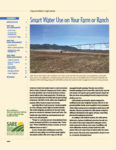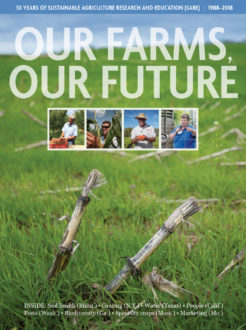Extreme drought. Intense rainfall and flooding. Algal blooms. Dwindling aquifers. Urban competition. When it comes to farmers and ranchers’ management of water, this most critical of natural resources, the pressure is on.
Yet, as agriculture’s relationship to water is redefined by changing weather patterns, intensification and urban growth, sustainable paths forward are emerging. They draw from both modern technologies and age-old practices, and have involved innovative research by SARE grantees at every step. Take cover crops and reduced tillage, for example. These two practices, long championed by SARE-funded researchers and farmers for their capacity to reduce erosion during heavy storms and keep excess nitrate out of waterways (see the soil health section of this report), can be effective water-management tools as well. They protect the soil from the impact of raindrops and improve water infiltration during intense rainfall events.
In areas where water is increasingly scarce, SARE grantees are turning to the principle of diversification by adding low-water-use crops and forages to production systems. (See the story, As the Ogallala Aquifer Dwindles, Long-Term Research Seeks a New Future.) They are also restoring native grasslands and more carefully managing livestock grazing.
SARE grantees are helping producers conserve water by implementing and refining more efficient irrigation systems like deficit irrigation and subsurface micro-irrigation, and by using soil moisture data to determine how much water to apply and when.
By the Numbers - SARE Grants on Water, 1988–2017
Getting the Word Out

SARE produces dozens of educational resources on a range of sustainable agriculture topics. Grantees produce even more with SARE funding. Here are just a few examples that address water issues (or see all SARE resources on water management):
Print: 22,222 | Online: 32,397
Online only: 4,506
Print: 34,928 | Online: 10,775
“Print” is copies distributed since the date of publication. “Online” is combined downloads and unique page views over a recent six-year period.
Visit the database of project reports to explore SARE-funded research on these topics.
![]()
411 grants | $20.6 million
![]()
23 grants | $901,323
![]() 73 grants | $6 million
73 grants | $6 million
![]()
219 grants | $6.5 million
![]()
460 grants | $14.4 million
![]()
89 grants | $3.1 million
![]()
184 grants | $6.5 million
![]()
265 grants | $11 million
1,100 grants | $45 million
Because some projects address more than one topic, the total is adjusted to remove duplicates.

